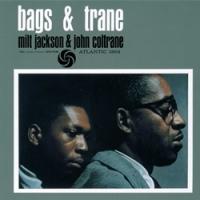Bags & Trane: The Odd Couple That Swings Well Together
The Modern Jazz Quartet had recorded with Sonny Rollins for both Prestige (with Rollins leading) and later for Atlantic (SD 1299) so this pairing go wasn't without precedent. This isn't an MJQ record though with MJQ drummer Connie Kay onboard it feels like one. Hank Jones replaces John Lewis on piano, while Paul Chambers fills in on bass for Percy Heath. So even though it's not an MJQ record, in places it sounds and feels much like one but in other places not so much.
The set opens with the title track by Jackson, which sounds like something slinky from "The Pink Panther" or like Bobby Timmons' "Moanin'". Clearly the group meshes well and we're off to a great, MJQ-like start with Jones slyly meandering ala Lewis and Chambers sawing with a bow on his upright. It's a cool groove.
The mix is early left/right with drums and vibraphone, piano right channel, sax and bass left channel, meaning this could arguably have been fine too as a mono reissue. Coltrane's sax is surrounded by either room sound or deftly placed fast reverb.
Side two opens with the standard "Three Little Words". Jones starts it off, Jackson repeats the familiar melody and then it's Coltrane's turn. He's good for "Three lit…" before he's off into improv land with everyone else in non-melodic pursuit. That track does not sound like the MJQ with everyone, especially Jones, propelled forward by Coltrane.
Side 3's cover of Dizzy's "Be-Bop" is a high speed chase led by Coltrane with Jackson and Jones in lock-step and Kay furiously but gently hitting the cymbals. Coltrane is off to the races on this one with Jones keeping up nicely during his solo turns.
The albums ends with "The Late Late Blues", which brings the set full circle back to MJQ territory. The attraction here are not the compositions, but the individual and ensemble playing, both of which are nothing less than pleasurable throughout and occasionally downright thrilling.
The 1959 recording is decent but not spectacular. The miking is somewhat distant and the unnatural spread doesn't increase the sense of coherent space. Still, this version is a giant step ahead of the version included in Rhino's now almost twenty year old "TheHeavyweight Champion" box set.
This is far more spacious, dynamic and tonally rich. Why? The box lists four remastering engineers but only one, Geoff Sykes (GS) cut all of the vinyl. That tells me the source was digital, though transferred from the master tapes.
Here, Bernie Grundman cut directly from the master tapes all-analog. Not surprisingly it sounds better overall but particularly spatially, with more air and context around Coltrane's horn. Keep in mind that there's occasional over-modulation on the vibes and piano. It's not your cartridge mistracking.
The copy I received was not in a "tip on" jacket but ORG Music tells me that after the early run the packaging was improved.




